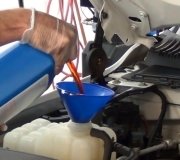Okay, the cooling system starts off full, radiator full and bottle at full cold. You start the engine, and it heats up. As it does the coolant will expand as it heats up. (Has to do with how the water absorbs the heat and makes the molecules speed up and expand to store heat, then they hit the radiator and dissipate the heat out into the air) Now you have HOT expanding liquid. Liquids don't compress, so unless you want that full radiator to split open you need a place for it to go. On modern cars it pushes the spring on the radiator cap open and releases some pressurized hot coolant into the overflow reservoir or expands in the pressure bottle. So now the engine is fully hot, and the coolant is doing its job. You get home and shut the engine off. For a bit the engine will actually cause the coolant temp to rise even more because there is no coolant flowing. That ends and the engine starts to cool down. The coolant starts to condense as it releases the heat. As it does it starts to leave a void inside the radiator and engine. That void is a vacuum point. In a vehicle with a reservoir this is the point that the second valve in the cap opens under that vacuum, and it pulls coolant back into the radiator. This does two things, one it keeps air out of the cooling system. Rust and aluminum oxide inside the cooling system will destroy an engine very rapidly. So, to prevent that air entry into the system to help prevent that corrosion. It at the same time removes the air to prevent any from being drawn into the engine and causing a hot spot in the engine due to the lack of water flow through the air pocket.
Now in a vehicle with no leaks and a properly operating cooling system any coolant lost would be a miniscule amount through the secondary overflow tube. So maybe over the course of 2 years it might evaporate a teaspoon. Any coolant loss over that means you have a leak somewhere.
If you are saying that you top it up cold. Then drive it around and have to add coolant again within a couple of days, you have a leak somewhere. Either external, like a pinhole in the radiator that leaks out hot coolant that evaporates in the air, or internal, IE a head gasket that is starting to fail.
Saturday, June 17th, 2023 AT 1:00 PM







